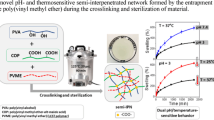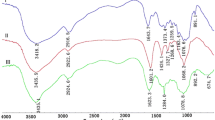Abstract
Interpenetrating polymer networks (IPN) consisting of pH-sensitive carboxymethyl pullulan (CMP) and thermosensitive poly(N-isopropylacrylamide) (PNIPAAm) were synthesized through a two-step procedure by chemical cross-linking of NIPAAm in the presence of CMP, followed by additional reticulation of the polysaccharide. The hydrogels were characterized by Fourier transform infrared spectroscopy, scanning electron microscopy and swelling measurements. Swelling properties of the hydrogels were studied at equilibrium, by investigating pH- and temperature-dependence, dynamic swelling ratio and pulsatile swelling-deswelling kinetics. It was found that IPN hydrogels responded to both temperature and pH changes and such stimuli-responsiveness was reversible. At pH 1.2 and temperature values lower than VPTT, the swelling ratios of IPN hydrogels are smaller than that of pure PNIPAAm because most of the carboxylic groups are protonated forming hydrogen bonds with other carboxylic or amide groups of PNIPAAm. Conversely, in phosphate buffer solutions at pH 7.4, the swelling ratios of IPN hydrogels are higher than that of pure PNIPAAm. In this case, the carboxylic groups of CMP are ionized; therefore, the hydrogen bonds are broken and the electrostatic repulsions lead to a more expanded network. The loading and release profiles of a model drug namely, diphenhydramine (DPH), were also evaluated. The results showed that the release rate of DPH was higher at pH 10 buffer solution than at pH 7.4 and 1.2, at 37 °C. In pseudo physiological conditions, DPH was quickly released from the hydrogel at 20 °C, and showed a sustained release profile at 37 °C.











Similar content being viewed by others
Abbreviations
- APS:
-
ammonium persulfate
- BIS:
-
N,N’-methylenebisacrylamide
- CMP:
-
carboxymethyl pullulan
- DPH:
-
diphenhydramine hydrochloride
- ESEM:
-
environmental scanning electron microscopy
- GA:
-
glutaraldehyde
- IPN:
-
interpenetrating polymer network
- LCST:
-
lower critical solution temperature
- MCA:
-
monochloroacetic acid
- NIPAAm:
-
N-isopropylacrylamide
- P:
-
pullulan
- PBS:
-
phosphate buffer at pH 7.4
- TEMED:
-
N,N,N’,N’-tetramethylethylenediamine
- VPTT:
-
volume phase transition temperature
References
He C, Kim SW, Lee DS (2008) J Control Release 127:189–207
Hoare TR, Kohane DS (2008) Polymer 49:1993–2007
Schmaljohann D (2006) Adv Drug Deliv Rev 58:1655–1670
Doria-Serrano MC, Ruiz-Treviño FA, Rios-Arciga C, Hernández-Esparza M, Santiago P (2001) Biomacromolecules 2:568–574
Serizawa T, Wakita K, Akashi M (2002) Macromolecules 35:10–12
Bromberg LE, Ron ES (1998) Adv Drug Deliv Rev 31:197–221
Park TG, Hoffman AS (1990) J Biomed Mater Res 24:21–38
Takeuchi S, Omodaka I, Hasegawa K, Maeda Y, Kitano H (1993) Angew Makromol Chem 194:1991–1993
Bao-Lin G, Qing-Yu G (2007) Carbohyd Res 342:2416–2422
Schild HG (1992) Prog Polym Sci 17:163–249
Wenceslau AC, dos Santos FG, Ramos ERF, Nakamura CV, Rubira AF, Muniz EC (2012) Mat Sci Eng C 32:1259–1265
Jeong B, Gutowska A (2002) Trends Biotechnol 20:305–311
Hu J, Zheng S, Xu X (2012) J Polym Res 19:9988–9996
Xu XD, Wei H, Zhang XZ, Cheng SX, Zhuo RX (2007) J Biomed Mater Res A 81:418–426
Huffman AS, Afrassiabi A, Dong LC (1986) J Control Release 4:213–222
Qiu Y, Park K (2001) Adv Drug Deliv Rev 53:321–339
Strachotová B, Strachota A, Uchman M, Šlouf M, Brus J, Pleštil J, Matějka L (2007) Polymer 48:1471–1482
Ebara M, Aoyagi T, Sakai K, Okano T (2001) J Polym Sci Pol Chem 39:335–342
Zhang JT, Cheng SX, Zhou RX (2003) Colloid Polym Sci 281:580–583
Zhang GQ, Zha LS, Zhou MH, Ma JH, Liang BR (2005) Colloid Polym Sci 283:431–438
Zhang XZ, Lewis PJ, Chu CC (2005) Biomaterials 26:3299–3309
Aguilar MR, Elvira C, Gallardo A, Vázquez B, Román JS (2007) In: Ashammakhi N, Reis R, Chiellini E (eds) Topics in tissue engineering. EXPERTISSUES, Helsinki
Zhao SP, Zhou F, Li L-Y (2012) J Polym Res 19:9944–9952
Wallenfells K, Bender H, Keilich G, Bechtler G (1961) Angew Chem 73:245–246
Leathers TD (2003) Appl Microbiol Biot 62:468–473
Yamaoka T, Tabata Y, Ikada Y (1993) Drug Deliv 1:75–82
Zhang XZ, Yang YY, Wang FJ, Cheng TS (2002) Langmuir 18:2013–2018
Kimono T, Shibuya T, Isóbara S (1997) Food Chem Toxic 35:323–329
Rekha MR, Sharma CP (2007) Trends Biomater Artif Organs 20:116–121
Xi K, Tabata Y, Uno K, Yoshimoto M, Kishida T, Sokawa Y, Ikada Y (1996) Pharm Res 13:1846–1850
Hosseinkhani H, Aoyama T, Ogawa O, Tabata Y (2002) J Control Release 83:287–302
Prajapati VD, Jani GK, Canda SM (2013) Carbohyd Polym 95:540–549
Mitchell G, Wijnberg AC (1997) Starch/Stark 49:485–488
Ngah WSW, Endud CS, Mayanar R (2002) React Funct Polym 50:181–190
Thirumavalavan K, Manikkadan TR, Dhanasekar R (2009) Afr J Biotechnol 8:254–258
Gupta KC, Khandekar K (2003) Biomacromolecules 4:758–765
Zeng F, Tong Z, Yang X (1997) Eur Polym J 33:1553–1556
Guyomard A, Nysten B, Muller G, Glinel K (2006) Langmuir 22:2281–2287
Alvarez-Lorenzo C, Concheiro A, Dubovik AS, Grinberg NV, Burova TV, Grinber VY (2005) J Control Release 102:629–641
Fu G, Soboyejo WO (2010) Mat Sci Eng C 30:8–13
Alvarez-Lorenzo C, Guney O, Oya T, Sakai Y, Kobayashi M, Enoki T, Takeoka Y, Ishibashi T, Kuroda K, Tanaka K, Wang G, Grosberg AY, Masamune S, Tanaka T (2000) Macromolecules 33:8693–8697
Li G, Guo L, Chang X, Yang M (2012) Int J Biol Macrom 50:899–904
Lipatov YS (2002) Prog Polym Sci 27:1721–1801
De Moura MR, Aouada FA, Favaro SL, Radovanovic E, Rubira AF, Muniz EC (2009) Mat Sci Eng C 29:2319–2325
Wang XH, Qiu XP, Wu C (1998) Macromolecules 31:2972–2976
Grinberg VY, Dubovik AS, Kuznetsov DV, Grinberg NV, Grosberg AY, Tanaka T (2000) Macromolecules 33:8685–8692
Ju HK, Kim SY, Lee YM (2001) Polymer 42:6851–6857
Reis AV, Guilherme MR, Rubira AF, Muniz EC (2007) J Colloid Interf Sci 310:128–135
Fundueanu G, Constantin M, Ascenzi P (2008) Biomaterials 29:2767–2775
Fundueanu G, Constantin M, Esposito E, Cortesi R, Nastruzzi C, Menegatti E (2005) Biomaterials 26:4337–4347
Acknowledgments
This work was supported by a grant of the Romanian National Authority for Scientific Research, CNCS – UEFISCDI, project number PN-II-ID-PCCE-2011-2-0028.
M. Constantin acknowledges the financial support of the European Social Fund – “Cristofor I. Simionescu” Postdoctoral Fellowship Programme (ID POSDRU/89/1.5/S/55216), Sectoral Operational Programme Human Resources Development 2007–2013.
Author information
Authors and Affiliations
Corresponding author
Rights and permissions
About this article
Cite this article
Asmarandei, I., Fundueanu, G., Cristea, M. et al. Thermo- and pH-sensitive interpenetrating poly(N-isopropylacrylamide)/carboxymethyl pullulan network for drug delivery. J Polym Res 20, 293 (2013). https://doi.org/10.1007/s10965-013-0293-3
Received:
Accepted:
Published:
DOI: https://doi.org/10.1007/s10965-013-0293-3




